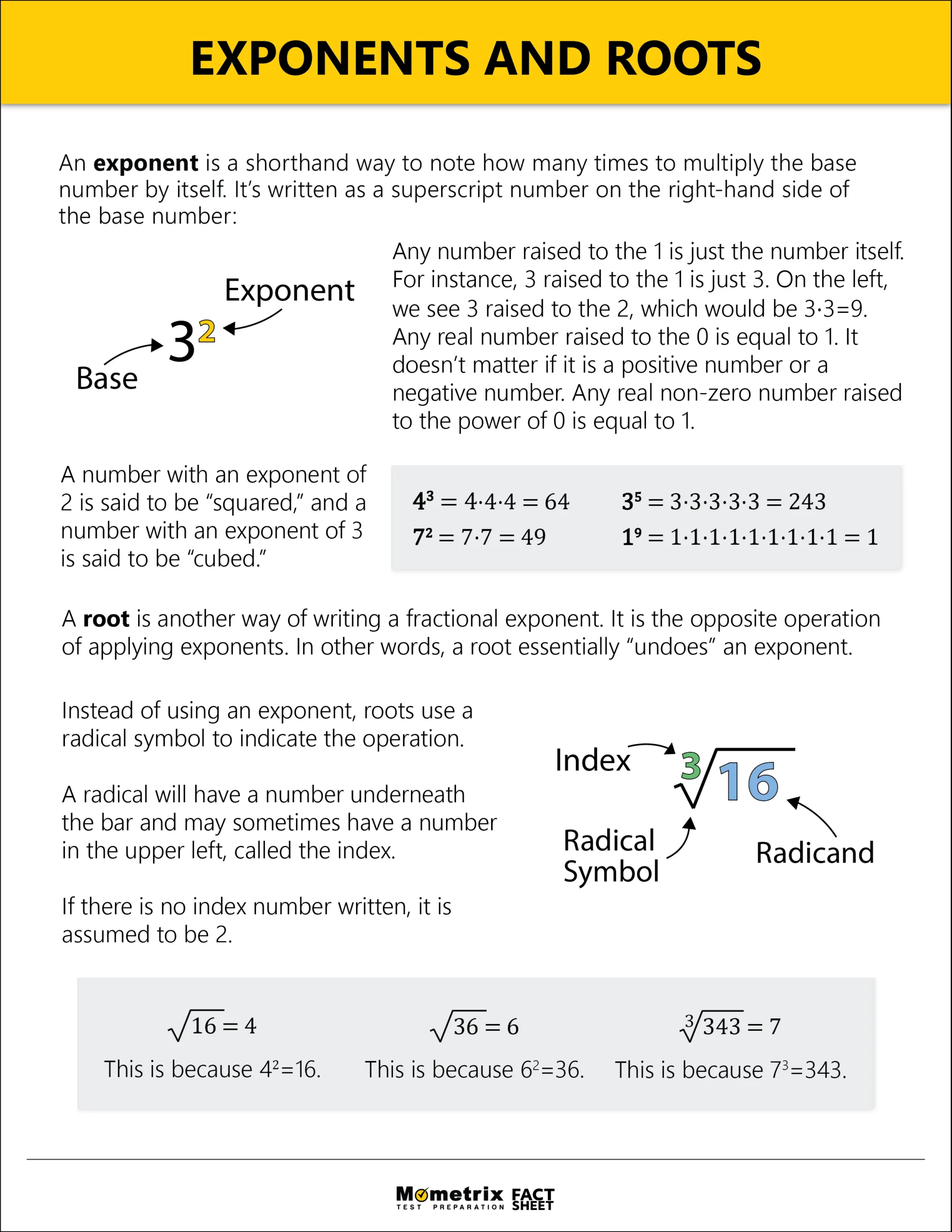
Hi, and welcome to this video on solving equations with exponents! Today we will review what exponents are and see how to work with exponents to solve an equation. Let’s get started!
Exponents
Before we dive in, let’s remember what exponents are. Exponents are numbers that tell you how many times to multiply another number by itself.
For example, if we have four to the third power, 4³, our exponent, three, tells us to multiply four by itself three times. So four to the third power is equal to four times four times four, which is equal to 64.
Another important fact to remember about exponents is that if you put a negative number to an even power, the answer will be positive. For instance, negative 3 squared is the same as multiplying negative 3 times negative 3, and when we multiply a negative times a negative that gives you a positive answer of 9 since a negative times a negative equals a positive.
This will be very important to our solutions later!
What is the Opposite of an Exponent?
One other thing to consider before we start solving equations is the opposite of an exponent. When we are solving equations and want to get rid of a plus three from one side, we do the opposite operation and subtract three from both sides. Similarly, if we are dividing one side by four and we want to undo that, we multiply both sides by 4.
Following this pattern, if we want to undo an exponent on one side, we are going to need to do the opposite operation to both sides. The opposite of exponents are roots. So if we have a square on one side that we want to get rid of, we will want to square root both sides to undo our square.
Solving Equations with Exponents
Now that we’ve covered the basics, let’s jump into actually solving an equation. We are going to start with a super simple one.
Example #1
The first thing we need to do is to get \(x\) by itself. In order to do that, we will need to undo that power of three. The opposite of exponents are roots, so we take the third root, from both sides. The third root is also known as the cube root.
The cube root of 64 is 4, so \(x\) is equal to 4.
Example #2
Let’s try one that involves a few more steps.
Our first step in solving this equation is adding 4 to both sides.
Next, we want to get our \(x\) squared by itself so we will divide by 3 on both sides.
Finally, we want to square root both sides to get \(x\) by itself.
When we do this, we get that \(x = ± 4\). Remember, when we have even roots, we need to consider both the positive and negative answers.
We can check our answers by plugging them back into the original equation.
So we have \(3(4)^2-4=3 \cdot 16-4=48-4=44\), which is what we were looking for, so that one works!
Now let’s try negative 4:
Example #3
Let’s try one more example together:
In this example, our first step is to undo the square since the whole function is squared.
If we take the square root of both sides, we get \(2x+7=\pm 3\).
We now need to set up two different equations to find our answer.
If we solve each of these individually it will give us our two answers.
First, we’re going to subtract 7 from both sides, which gives us \(2x=-4\). Divide by 2 on both sides and get \(x=-2\).
For our other answer, we’re going to do the same thing. We’re going to subtract 7 from both sides, which gives us \(2x=-10\), and divide by 2 on both sides, which gives us \(x=-5\).
Our two answers are \(x=-2\) and \(x=-5\). Let’s double-check by plugging them into our original equation:
Example #4
Before we go, I want you to try one more on your own. Once I give you the equation, pause the video and try it on your own. Once you have your answer, press play and see if it matches up with mine.
Think you’ve got it? Let’s see!
First, we want to add 9 to both sides.
Then we want to cube root both sides to undo the third power.
Remember, we don’t need to consider negative 3 because we are undoing an odd exponent. You only consider both positive and negative answers when you have an even power.
Next, we are going to subtract 3 from both sides and divide by 2.
This gives us our final answer of \(x = 0\).
We can check our answer by plugging it into the original equation.
Plugging our answer back into the original equation gives us 18, which is what our original equation says we should get.
I hope this review on solving equations with exponents was helpful. Thanks for watching and happy studying!
Exponents and Roots Review PDF
Equations with Exponents Practice Questions
Which expression is equal to \(-5^4\)?
\(-5^4\) is the same as multiplying -5 four times. Therefore, the correct answer is
\(-5\times-5\times-5\times-5\).
Find the value of x in the equation \(2x^2=32\).
To find the answer, solve for x in the equation.
\(2x^2=32\)
First, isolate the variable by doing inverse operations. Since the opposite of multiplying by 2 is dividing by 2, divide both sides of the equation by 2.
\(\frac{2x^2}{2}=\frac{32}{2}\)
2 divided by 2 equals 1. Since \(1x^2\) is the same as \(x^2\), rewrite the left side of the equation as \(x^2\). Since 32 divided by 2 equals 16, write 16 on the right side of the equation.
\(x^2=16\)
Next, isolate the variable by performing inverse operations to remove the exponent. Since the opposite of an exponent is a root, square root both sides of the equation.
\(\sqrt{x^2}=\sqrt{16}\)
The square root of \(x^2\) equals \(x\), and the square root of 16 equals ±4. Remember that \(4^2=16\) and \((-4)^2=16\). Therefore, \(x\) is equal to both 4 and -4.
\(x=\pm4\)
To check your work, substitute each solution back into the equation. Since \(4^2\) equals 16 and 2 times 16 equals 32, 4 is a solution to the equation.
\(2(4)^2=32\)
\(32=32\)
To check your work, substitute each solution back into the equation. Since \((-4)^2\) equals 16 and 2 times 16 equals 32, -4 is also a solution to the equation.
\(2(-4)^2=32\)
\(2(16)=32\)
\(32=32\)
Find the value of \(x\) in the equation \(4x^2+8=24\).
To find the answer, solve for x in the equation.
\(4x^2+8=24\)
First, isolate the variable by doing inverse operations, starting with addition and subtraction. Since the opposite of adding 8 is subtracting 8, subtract both sides of the equation by 8.
\(4x^2+8-8=24-8\)
8 minus 8 equals 0, so the 8 is canceled out on the left side of the equation. Since 24 minus 8 equals 16, write 16 on the right side of the equation.
\(4x^2=16\)
Next, isolate the variable by performing inverse operations. Since the opposite of multiplying by 4 is dividing by 4, divide both sides of the equation by 4.
\(\frac{4x^2}{4}=\frac{16}{4}\)
4 divided by 4 equals 1. Since \(1x^2\) is the same as \(x^2\), rewrite the left side of the equation as \(x^2\). Since 16 divided by 4 equals 4, write 4 on the right side of the equation.
\(x^2=4\)
Next, isolate the variable by performing inverse operations to remove the exponent. Since the opposite of an exponent is a root, square root both sides of the equation.
\(\sqrt{x^2}=\sqrt{4}\)
The square root of \(x^2\) equals \(x\) and the square root of 4 equals ±2. Remember that \(2^2=4\) and \((-2)^2=4\). Therefore, \(x\) is equal to 2 and -2.
\(x=\pm2\)
To check your work, substitute each solution back into the equation. \(2^2\) equals 4 and 4 times 4 equals 16. 16 plus 8 equals 24. Therefore, 2 is a solution to the equation.
\(4(2)^2+8=24\)
\(4(4)+8=24\)
\(16+8=24\)
\(24=24\)
To check your work, substitute each solution back into the equation. \((-2)^2\) equals 4 and 4 times 4 equals 16. 16 plus 8 equals 24. Therefore, -2 is a solution to the equation.
\(4(-2)^2+8=24\)
\(4(4)+8=24\)
\(16+8=24\)
\(24=24\)
Jamal and Chase are working on an extra credit problem in math class. They need to find the value of x in the equation \((3x-5)^2=16\). After working independently, Jamal says the equation has two solutions for x. Chase says there is only one solution for x. Who is correct?
To find the answer, solve for x in the equation.
\((3x-5)^2=16\)
First, isolate the variable by doing inverse operations to remove the exponent. Since the opposite of an exponent is a root, square root both sides of the equation.
\(\sqrt{(3x-5)^2}=\sqrt{16}\)
The square root of \((3x-5)^2\) is \((3x-5)\) and the square root of 16 is ±4. Remember that \(4^2=16\) and \((-4)^2=16\).
\(3x-5=\pm4\)
Next, set up two equations for 4 and -4 and solve for x.
\(3x-5=4\) and \(3x-5=-4\)
Looking at the first equation, isolate the variable by doing inverse operations, starting with addition and subtraction. Since the opposite of subtracting 5 is adding 5, add 5 to both sides of the equation.
\(3x-5+5=4+5\)
-5 plus 5 equals 0, so the -5 is canceled out on the left side of the equation. Since 4 plus 5 equals 9, write 9 on the right side of the equation.
\(3x=9\)
Since the opposite of multiplying by 3 is dividing by 3, isolate the variable by dividing both sides of the equation by 3.
\(\frac{3x}{3}=\frac{9}{3}\)
3 divided by 3 equals 1, and 9 divided by 3 equals 3. Therefore x equals 3.
\(x=3\)
Looking at the second equation, isolate the variable by doing inverse operations, starting with addition and subtraction. Since the opposite of subtracting 5 is adding 5, add 5 to both sides of the equation.
\(3x-5+5=-4+5\)
-5 plus 5 equals 0, so the -5 is canceled out on the left side of the equation. Since -4 plus 5 equals 1, write 1 on the right side of the equation.
\(3x=1\)
Since the opposite of multiplying by 3 is dividing by 3, isolate the variable by dividing both sides of the equation by 3.
\(\frac{3x}{3}=\frac{1}{3}\)
3 divided by 3 equals 1, and 1 divided by 3 equals \(\frac{1}{3}\). Therefore x equals \(\frac{1}{3}\).
\(x=\frac{1}{3}\)
Since two equations were set up to solve for x, there are two solutions for x: \(x=3\) and \(x=\frac{1}{3}\).
\(x=3\) and \(x=\frac{1}{3}\)
A cube’s volume is 64 cubic centimeters and each side of the cube is \(2x-6\) centimeters. Using the equation \((2x-6)^3=64\), what is the value of x?
To find the answer, solve for x in the equation.
\((2x-6)^3=64\)
First, isolate the variable by doing inverse operations to remove the exponent. Since the opposite of an exponent is a root, cube root both sides of the equation.
\(\sqrt[3]{(2x-6)^3}=\sqrt[3]{64}\)
The cube root of \((2x-6)^3\) is \((2x-6)\) and the cube root of 64 is 4. Remember that we don’t need to consider -4 because we are undoing an odd exponent. Only consider both positive and negative answers when you have an even exponent.
\((2x-6)=4\)
Next, isolate the variable by doing inverse operations, starting with addition and subtraction. Since the opposite of subtracting 6 is adding 6, add 6 to both sides of the equation.
\(2x-6+6=4+6\)
-6 plus 6 equals 0, so the -6 is canceled out on the left side of the equation. Since 4 plus 6 equals 10, write 10 on the right side of the equation.
\(2x=10\)
Since the opposite of multiplying by 2 is dividing by 2, isolate the variable by dividing both sides of the equation by 2.
\(\frac{2x}{2}=\frac{10}{2}\)
2 divided by 2 equals 1, and 10 divided by 2 equals 5. Therefore x equals 5.
\(x=5\)


